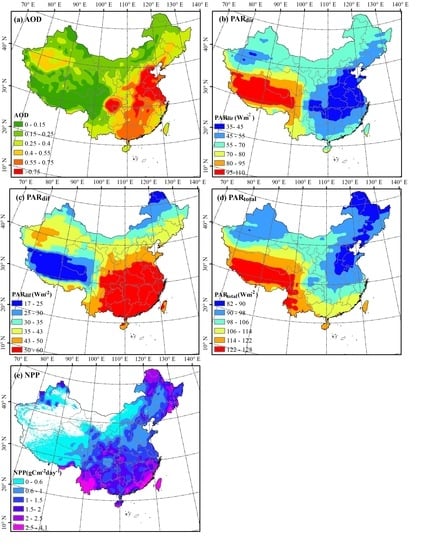Spatio-Temporal Variation in AOD and Correlation Analysis with PAR and NPP in China from 2001 to 2017
Abstract
1. Introduction
2. Materials and Methods
2.1. Study Area
2.2. Aerosol Data
2.3. PAR Data
2.4. NPP Data
2.5. Land Cover Data
2.6. Seasonal Kendall Trend Test
3. Results and Discussion
3.1. Spatio-temporal Variations in AOD, PAR and NPP
3.1.1. Annual Distribution
3.1.2. Seasonal Variation
3.1.3. Temporal Trend
3.2. The Correlations between AOD, PAR and NPP
3.3. Regional Analysis
3.3.1. Vegetation Cover
3.3.2. Typical Regions
4. Conclusions
Author Contributions
Funding
Acknowledgments
Conflicts of Interest
References
- Levy, R.C.; Mattoo, S.; Munchak, L.A.; Remer, L.A.; Sayer, A.M.; Patadia, F.; Hsu, N.C. The Collection 6 MODIS aerosol products over land and ocean. Atmos. Meas. Tech. 2013, 6, 2989–3034. [Google Scholar] [CrossRef]
- Malakar, N.K.; Lary, D.J.; Moore, A.; Gencaga, D.; Roscoe, B.; Albayrak, A.; Wei, J. Estimation and bias correction of aerosol abundance using data-driven machine learning and remote sensing. In Proceedings of the Intelligent Data Understanding (CIDU), Boulder, CO, USA, 24–26 October 2012. [Google Scholar]
- Tie, X.; Huang, R.J.; Dai, W.; Cao, J.; Long, X.; Su, X.; Zhao, S.; Wang, Q.; Li, G. Effect of heavy haze and aerosol pollution on rice and wheat productions in China. Sci. Rep. 2016, 6, 29612. [Google Scholar] [CrossRef]
- Chameides, W.L.; Yu, H.; Liu, S.C.; Bergin, M.H.; Zhou, X.; Mearms, L. Case study of the effects of atmospheric aerosols and regional haze on agriculture:an opportunity to enhance crop yields in China through emission controls. Proc. Natl. Acad. Sci. 1999, 96, 13626–13633. [Google Scholar] [CrossRef]
- He, Q.; Zhang, M.; Huang, B. Spatio-temporal variation and impact factors analysis of satellite-based aerosol optical depth over China from 2002 to 2015. Atmos. Environ. 2016, 129, 79–90. [Google Scholar] [CrossRef]
- Wang, P.; Ning, S.; Dai, J.; Sun, J.; Lv, M.; Song, Q.; Dai, X.; Zhao, J.; Yu, D. Trends and Variability in Aerosol Optical Depth over North China from MODIS C6 Aerosol Products during 2001–2016. Atmosphere-Basel 2017, 8, 223. [Google Scholar] [CrossRef]
- Qin, W.; Liu, Y.; Wang, L.; Lin, A.; Xia, X.; Che, H.; Bilal, M.; Zhang, M. Characteristic and Driving Factors of Aerosol Optical Depth over Mainland China during 1980–2017. Remote Sens. 2018, 10, 1064. [Google Scholar] [CrossRef]
- Alfaro-Contreras, R.; Zhang, J.; Reid, J.S.; Christopher, S. A study of 15-year aerosol optical thickness and direct shortwave aerosol radiative effect trends using MODIS, MISR, CALIOP and CERES. Atmos. Chem. Phys. 2017, 17, 13849–13868. [Google Scholar] [CrossRef]
- Yue, X.; Unger, N. Aerosol optical depth thresholds as a tool to assess diffuse radiation fertilization of the land carbon uptake in China. Atmos. Chem. Phys. 2017, 17, 1329–1342. [Google Scholar] [CrossRef]
- Cohan, D.S.; Xu, J.; Greenwald, R.; Bergin, M.H.; Chameides, W.L. Impact of atmospheric aerosol light scattering and absorption on terrestrial net primary productivity. Global. Biogeochem. Cy. 2002, 16, 37-1. [Google Scholar] [CrossRef]
- Kumar, S.; Kumar, S. Impact of aerosol on climate and productivity of rice and wheat crop in Bihar. J. Agrometeorol. 2017, 19, 23–28. [Google Scholar]
- Wang, J.; Dong, J.; Yi, Y.; Lu, G.; Oyler, J.; Smith, W.K.; Zhao, M.; Liu, J.; Running, S. Decreasing net primary production due to drought and slight decreases in solar radiation in China from 2000 to 2012. J. Geophys. Res. Biogeo. 2017, 122, 261–278. [Google Scholar] [CrossRef]
- Zhai, W.; Zhao, Y.; Wang, C.; Xia, X.; Xu, X. The Impacts of Radiation Effects of Atmospheric Aerosol on Rice Production in the Yangtze Delta Region. In Proceedings of the SPIE—The International Society for Optical Engineering, San Diego, CA, USA, 10 September 2008. [Google Scholar]
- Shang, E.; Xu, E.; Zhang, H.; Liu, F. Analysis of Spatiotemporal Dynamics of the Chinese Vegetation Net Primary Productivity from the 1960s to the 2000s. Remote Sens. 2018, 10, 860. [Google Scholar] [CrossRef]
- Zhang, X.; Pang, J. A comparison between atmospheric water vapour content retrieval methods using MSG2-SEVIRI thermal-IR data. Int. J. Remote Sens. 2015, 36, 5075–5086. [Google Scholar] [CrossRef]
- Chen, C.; Park, T.; Wang, X.; Piao, S.; Xu, B.; Chaturvedi, R.K.; Fuchs, R.; Brovkin, V.; Ciais, P.; Fensholt, R.; et al. China and India lead in greening of the world through land-use management. Nat. Sustain. 2019, 2, 122–129. [Google Scholar] [CrossRef]
- Hubanks, P.; Platnick, S.; King, M.; Ridgway, B. MODIS Algorithm Theoretical Basis Document No. ATBD-MOD-30 for Level-3 Global Gridded Atmosphere Products (08_D3, 08_E3, 08_M3) and Users Guide, Collection 006, Version 4.3; NASA-Goddard Space Flight Center: Greenbelt, MD, USA, 11 April 2018. [Google Scholar]
- Bilal, M.; Nazeer, M.; Qiu, Z.; Ding, X.; Wei, J. Global Validation of MODIS C6 and C6.1 Merged Aerosol Products over Diverse Vegetated Surfaces. Remote Sens. 2018, 10, 475. [Google Scholar] [CrossRef]
- Yu, Y.; Shi, J.; Wang, T.; Letu, H.; Yuan, P.; Zhou, W.; Hu, L. Evaluation of the Himawari-8 Shortwave Downward Radiation (SWDR) Product and its Comparison With the CERES-SYN, MERRA-2, and ERA-Interim Datasets. IEEE J-STARS 2019, 12, 519–532. [Google Scholar] [CrossRef]
- Wielicki, B.A.; Barkstrom, B.R.; Harrison, E.F.; Lee III, R.B.; Smith, G.L.; Cooper, J.E. Clouds and the Earth’s Radiant Energy System (CERES): An Earth Observing System Experiment. Bull. Amer. Meteor. Soc. 1996, 77, 853–868. [Google Scholar] [CrossRef]
- CERES Science Team. CERES_SYN1deg_Ed4A Data Quality Summary (10/3/2017); NASA Atmospheric Science Data Center (ASDC): Hampton, VA, USA, 2017. [Google Scholar]
- Rutan, D.A.; Kato, S.; Doelling, D.R.; Rose, F.G.; Nguyen, L.T.; Caldwell, T.E.; Loeb, N.G. CERES Synoptic Product: Methodology and Validation of Surface Radiant Flux. J. Atmos. Oceanic. Technol. 2015, 32, 1121–1143. [Google Scholar] [CrossRef]
- Zhao, F.; Xu, B.; Yang, X.; Jin, Y.; Li, J.; Xia, L.; Chen, S.; Ma, H. Remote Sensing Estimates of Grassland Aboveground Biomass Based on MODIS Net Primary Productivity (NPP) A Case Study in the Xilingol Grassland of Northern China. Remote Sens. 2014, 6, 5368–5386. [Google Scholar] [CrossRef]
- Gülbeyaz, O. Estimating Net Primary Productivity Of Forest Ecosystems Over Turkey Using Remote Sensing Approach. Ph.D. Thesis, Middle East Technical University, Ankara, Turkey, 2018. [Google Scholar]
- Running, S.W.; Nemani, R.; Glassy, J.M.; Thornton, P.E. MODIS Daily Photosynthesis (PSN) and Annual Net Primary Production (NPP) Product (MOD17), Algorithm Theoretical Basis Document; Version 3.0; University of Montana, SCF At-Launch Algorithm ATBD Documents. pp. 1–59. Available online: www.ntsg.umt.edu/modis/ATBD/ATBD_MOD17_v21.pdf (accessed on 29 April 1999).
- Running, S.; Mu, Q.; Zhao, M. MOD17A2H MODIS/Terra Gross Primary Productivity 8-Day L4 Global 500m SIN Grid V006. NASA EOSDIS Land Process. DAAC 2015. [Google Scholar] [CrossRef]
- Sulla-Menashe, D.; Friedl, M.A. User Guide to Collection 6 MODIS Land Cover (MCD12Q1 and MCD12C1) Product; USGS: Reston, VA, USA, 2018. [Google Scholar]
- Hamed, K.H.; Rao, A.R. A modified Mann-Kendall trend test for autocorrelated data. J. Hydrol 1998, 204, 182–196. [Google Scholar] [CrossRef]
- Yue, S.; Pilon, P.; Cavadias, G. Power of the Mann–Kendall and Spearman’s rho tests for detecting monotonic trends in hydrological series. J. Hydrol 2002, 259, 254–271. [Google Scholar] [CrossRef]
- Zhu, X.; He, H.; Liu, M.; Yu, G.; Sun, X.; Gao, Y. Spatio-temporal variation of photosynthetically active radiation in China in recent 50 years. J. Geogr. Sci. 2010, 20, 803–817. [Google Scholar] [CrossRef]
- Helsel, D.R.; Frans, L.M. Regional Kendall Test for Trend. Environ. Sci. Technol. 2006, 40, 4066–4073. [Google Scholar] [CrossRef] [PubMed]
- Hirsch, R.M.; Slack, J.R.; Smith, R.A. Techniques of trend analysis for monthly water quality data. Water Resour. Res. 1982, 18, 107–121. [Google Scholar] [CrossRef]
- Hess, A.; Iyer, H.; Malm, W. Linear trend analysis a comparison of methods. Atmos. Environ. 2001, 35, 5211–5222. [Google Scholar] [CrossRef]
- Luo, Z.; Wu, W.; Yu, X.; Song, Q.; Yang, J.; Wu, J.; Zhang, H. Variation of Net Primary Production and Its Correlation with Climate Change and Anthropogenic Activities over the Tibetan Plateau. Remote Sens. 2018, 10, 1352. [Google Scholar] [CrossRef]
- Wang, Q.; Qiu, H.-N. Situation and outlook of solar energy utilization in Tibet, China. Renew. Sust. Energ. Rev. 2009, 13, 2181–2186. [Google Scholar] [CrossRef]
- Xia, X.; Li, Z.; Holben, B.; Wang, P.; Eck, T.; Chen, H.; Cribb, M.; Zhao, Y. Aerosol optical properties and radiative effects in the Yangtze Delta region of China. J. Geophys. Res. 2007, 112. [Google Scholar] [CrossRef]
- Ryu, Y.; Jiang, C.; Kobayashi, H.; Detto, M. MODIS-derived global land products of shortwave radiation and diffuse and total photosynthetically active radiation at 5 km resolution from 2000. Remote Sens. Environ. 2018, 204, 812–825. [Google Scholar] [CrossRef]
- Xia, X.; Li, Z.; Wang, P.; Chen, H.; Cribb, M. Estimation of aerosol effects on surface irradiance based on measurements and radiative transfer model simulations in northern China. J. Geophys. Res. 2007, 112. [Google Scholar] [CrossRef]
- Lin, C.-A.; Chen, Y.-C.; Liu, C.-Y.; Chen, W.-T.; Seinfeld, J.H.; Chou, C.C.K. Satellite-Derived Correlation of SO2, NO2, and Aerosol Optical Depth with Meteorological Conditions over East Asia from 2005 to 2015. Remote Sens. 2019, 11, 1738. [Google Scholar] [CrossRef]
- Ji, D.; Zhang, J.; He, J.; Wang, X.; Pang, B.; Liu, Z.; Wang, L.; Wang, Y. Characteristics of atmospheric organic and elemental carbon aerosols in urban Beijing, China. Atmos. Environ. 2016, 125, 293–306. [Google Scholar] [CrossRef]
- Guo, J.; Xu, H.; Liu, L.; Chen, D.; Peng, Y.; Yim, S.H.L.; Yang, Y.; Li, J.; Zhao, C.; Zhai, P. The Trend Reversal of Dust Aerosol Over East Asia and the North Pacific Ocean Attributed to Large-Scale Meteorology, Deposition, and Soil Moisture. J. Geophys. Res. Atmos. 2019, 124, 10450–10466. [Google Scholar] [CrossRef]
- De Leeuw, G.; Sogacheva, L.; Rodriguez, E.; Kourtidis, K.; Georgoulias, A.K.; Alexandri, G.; Amiridis, V.; Proestakis, E.; Marinou, E.; Xue, Y.; et al. Two decades of satellite observations of AOD over mainland China using ATSR-2, AATSR and MODIS/Terra: Data set evaluation and large-scale patterns. Atmos. Chem. Phys. 2018, 18, 1573–1592. [Google Scholar] [CrossRef]
- Wei, J.; Sun, L. Comparison and Evaluation of Different MODIS Aerosol Optical Depth Products Over the Beijing-Tianjin-Hebei Region in China. IEEE J-STARS 2017, 10, 835–844. [Google Scholar] [CrossRef]
- Niemeier, U.; Schmidt, H. Changing transport processes in the stratosphere by radiative heating of sulfate aerosols. Atmos. Chem. Phys. 2017, 17, 14871–14886. [Google Scholar] [CrossRef]
- Myhre, G.; Berglen, T.F.; Myhre, C.E.L.; Isaksen, I.S.A. The radiative effect of the anthropogenic influence on the stratospheric sulfate aerosol layer. Tellus 2004, 56B, 294–299. [Google Scholar] [CrossRef][Green Version]
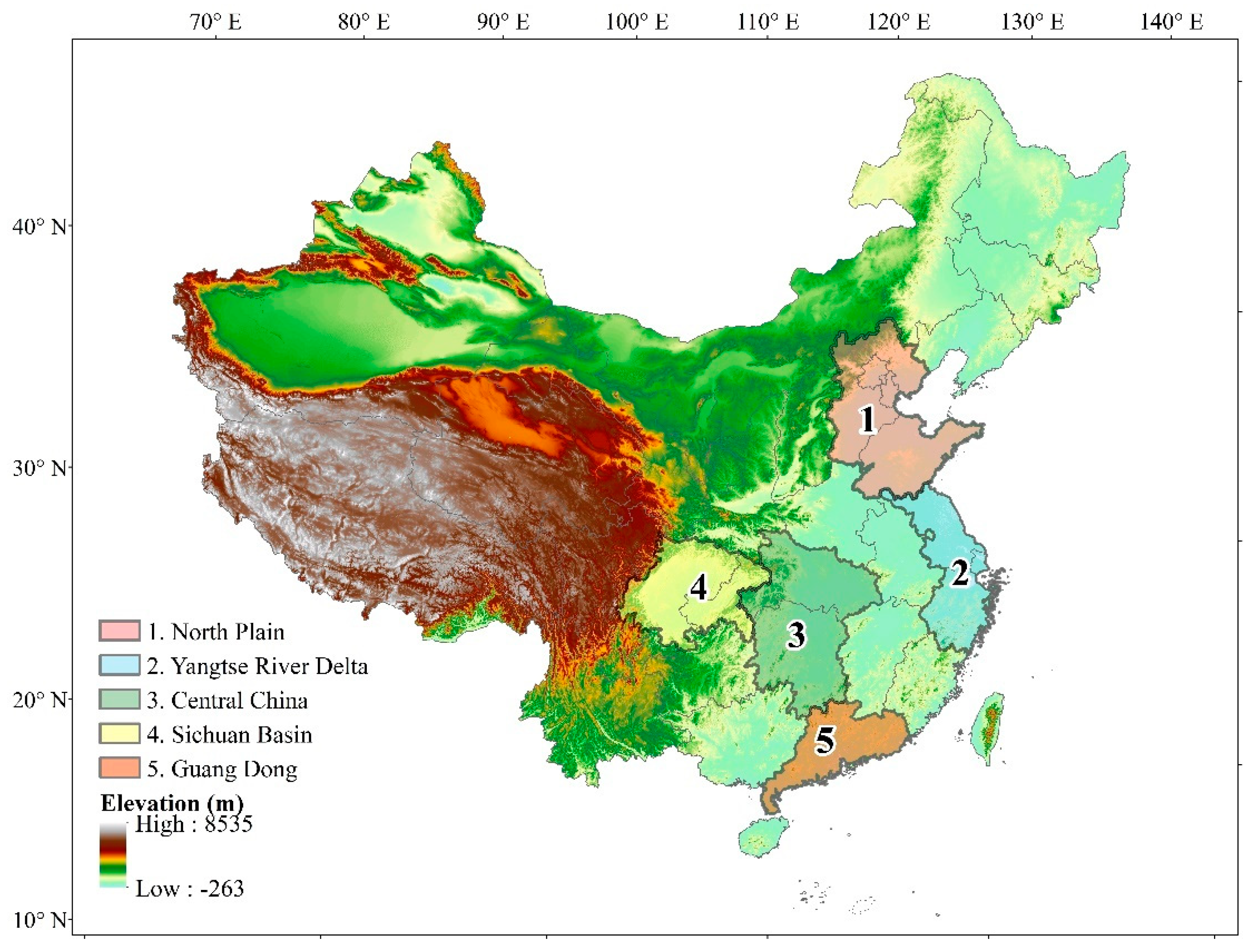

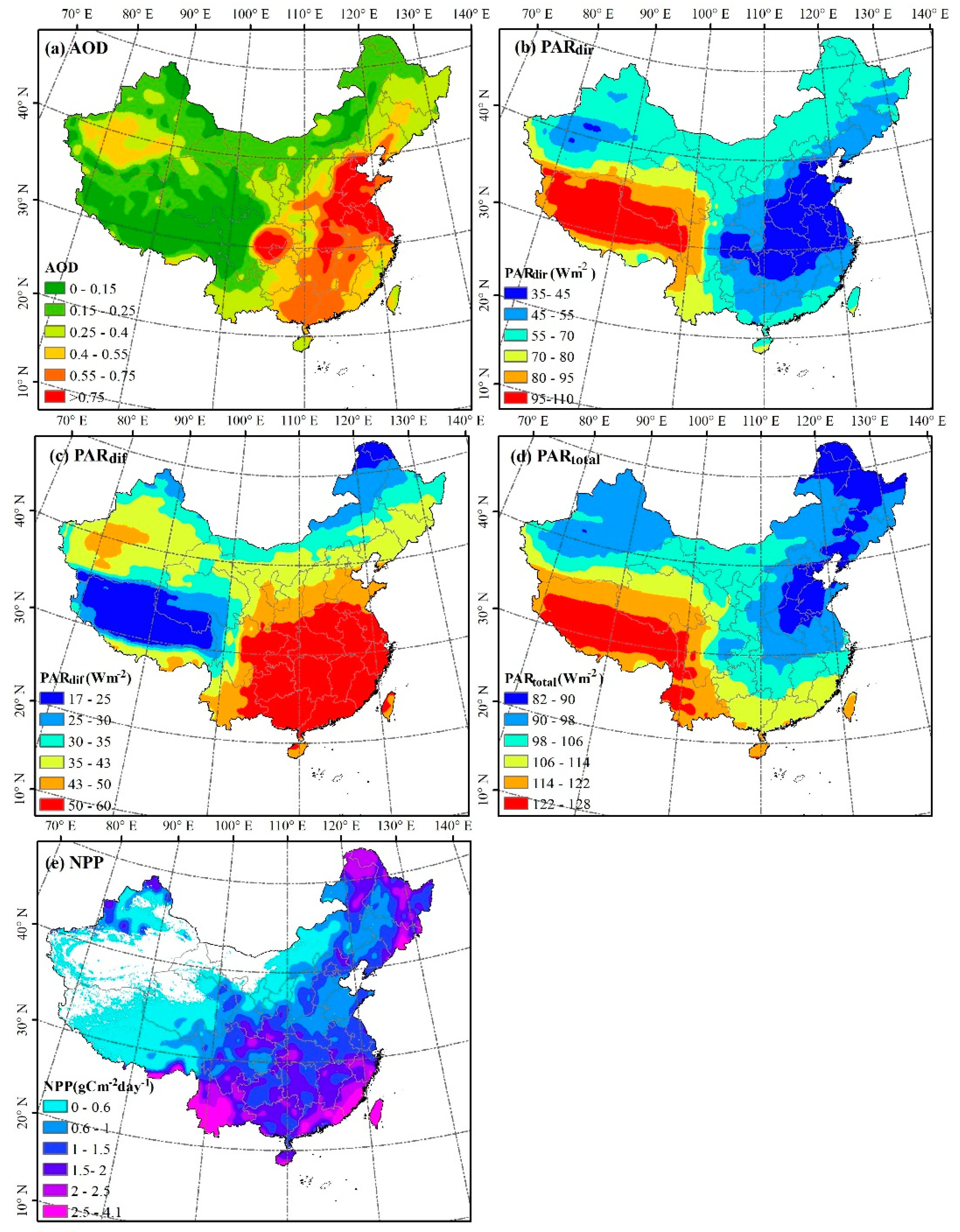
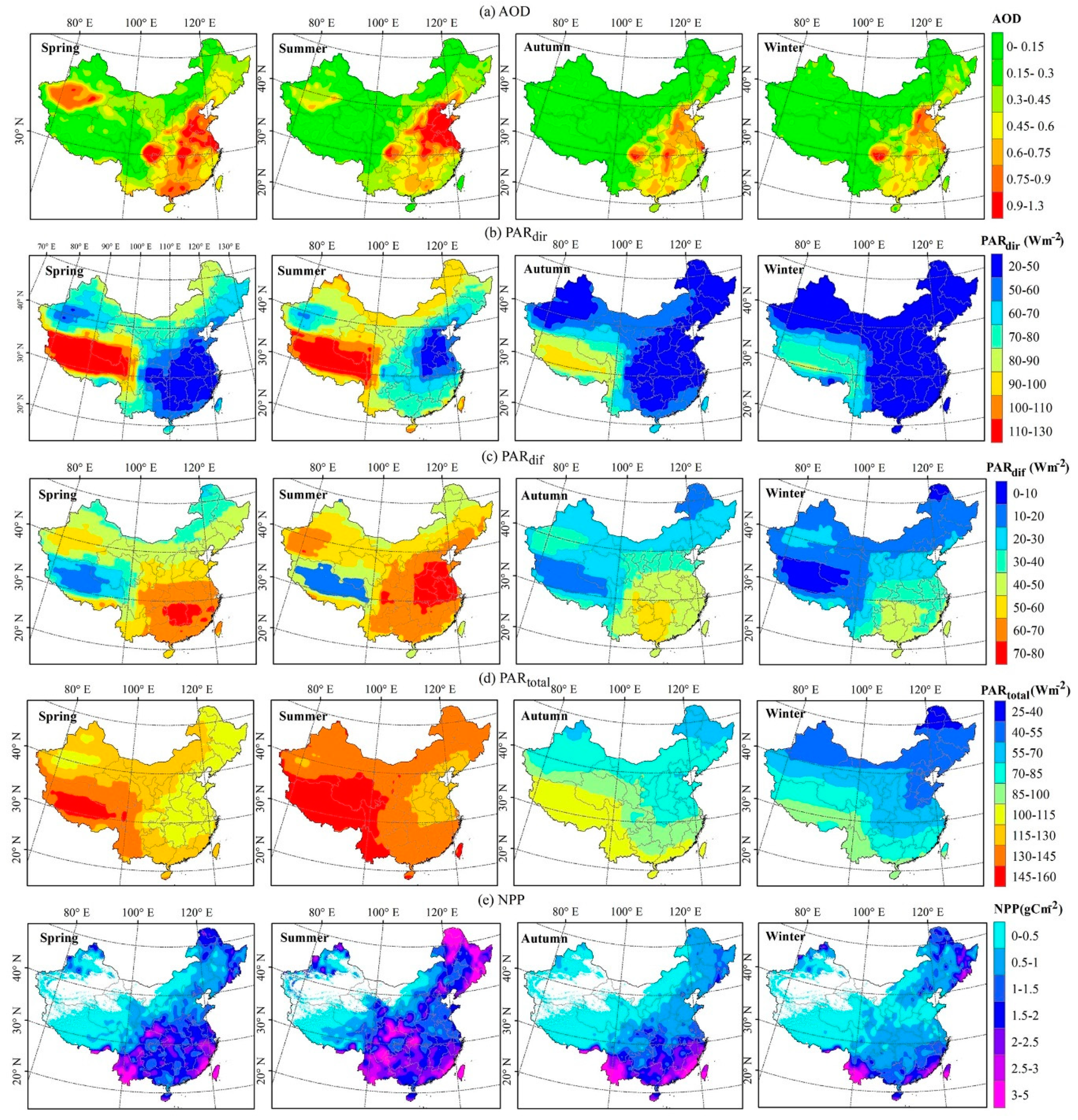
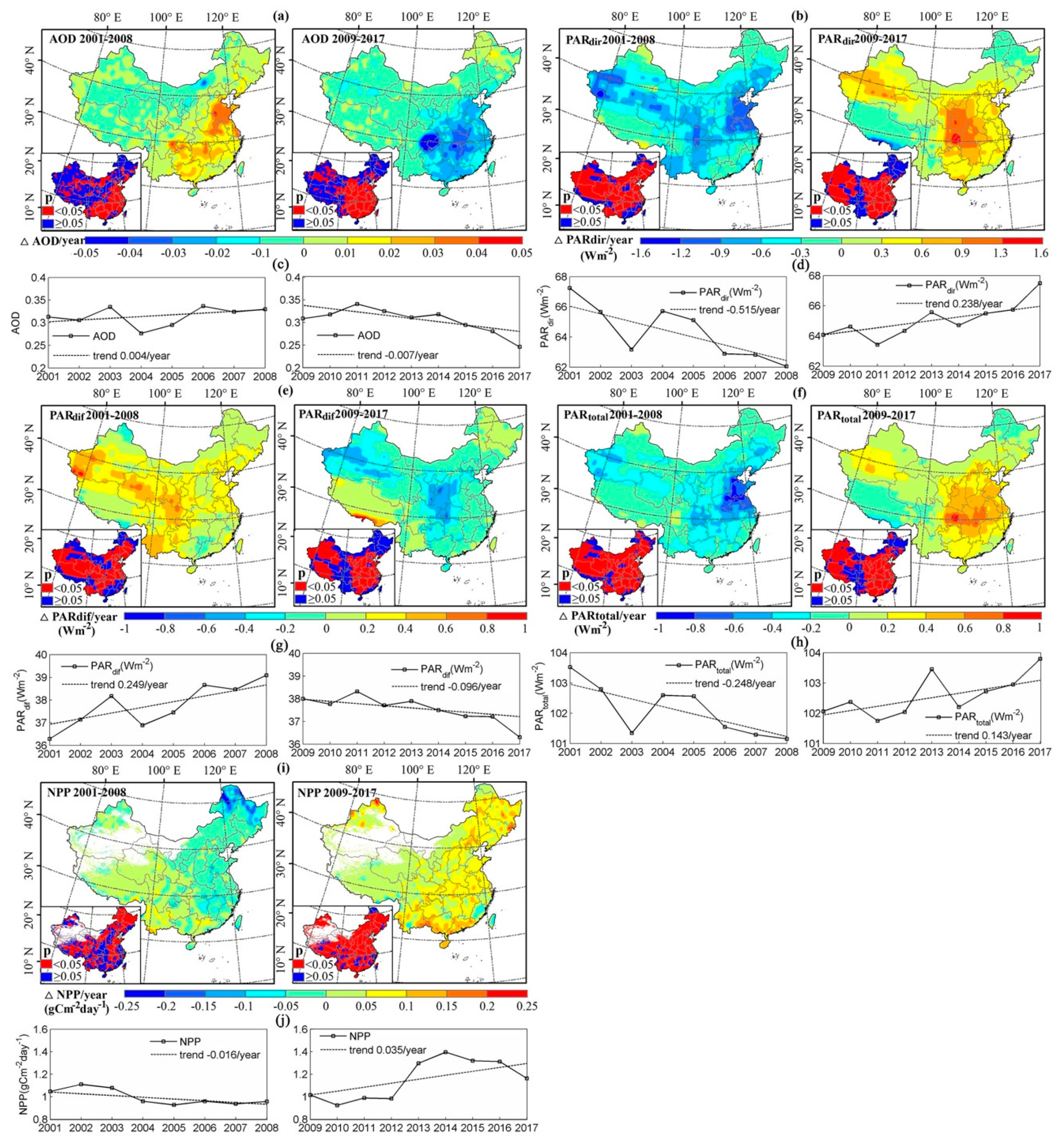
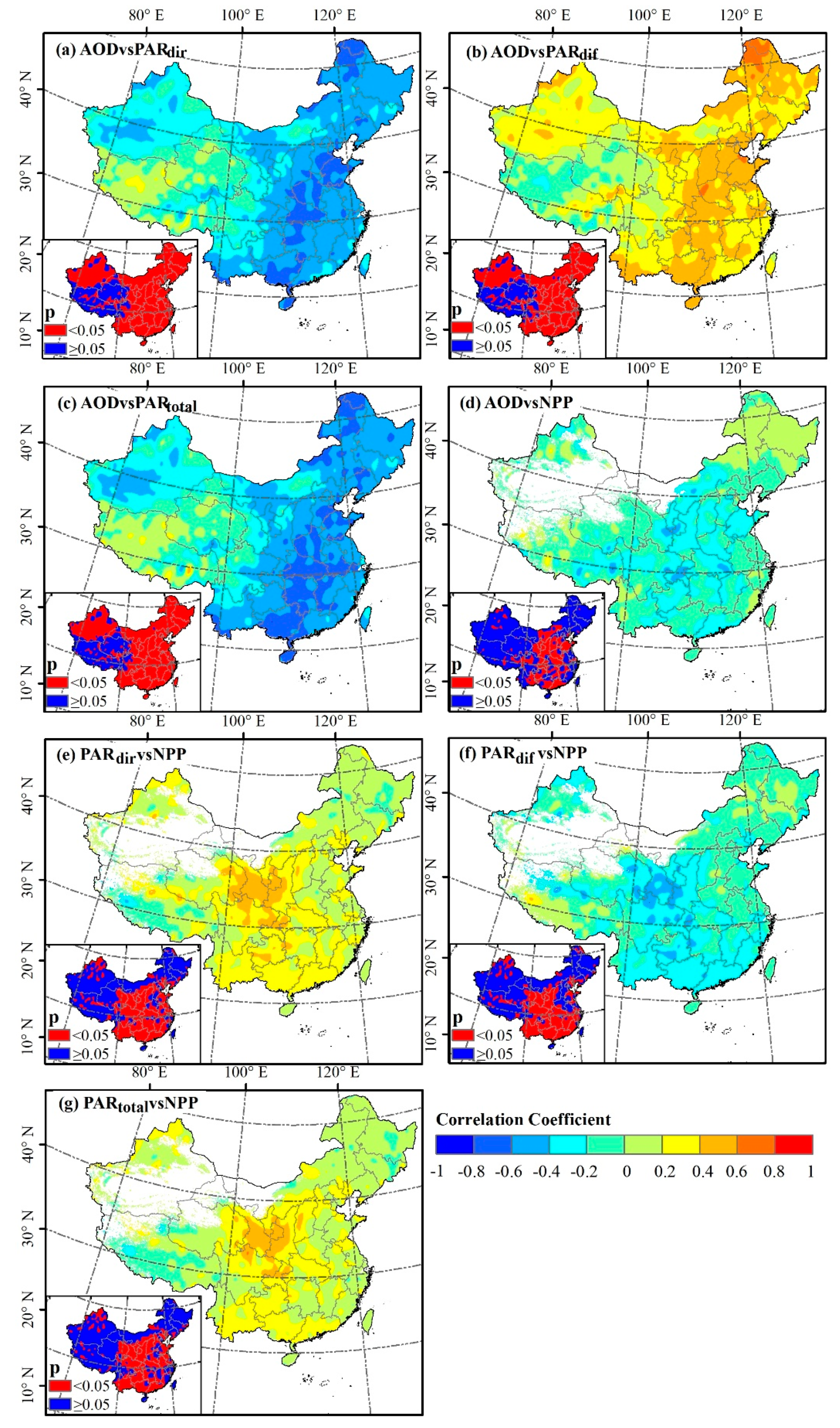
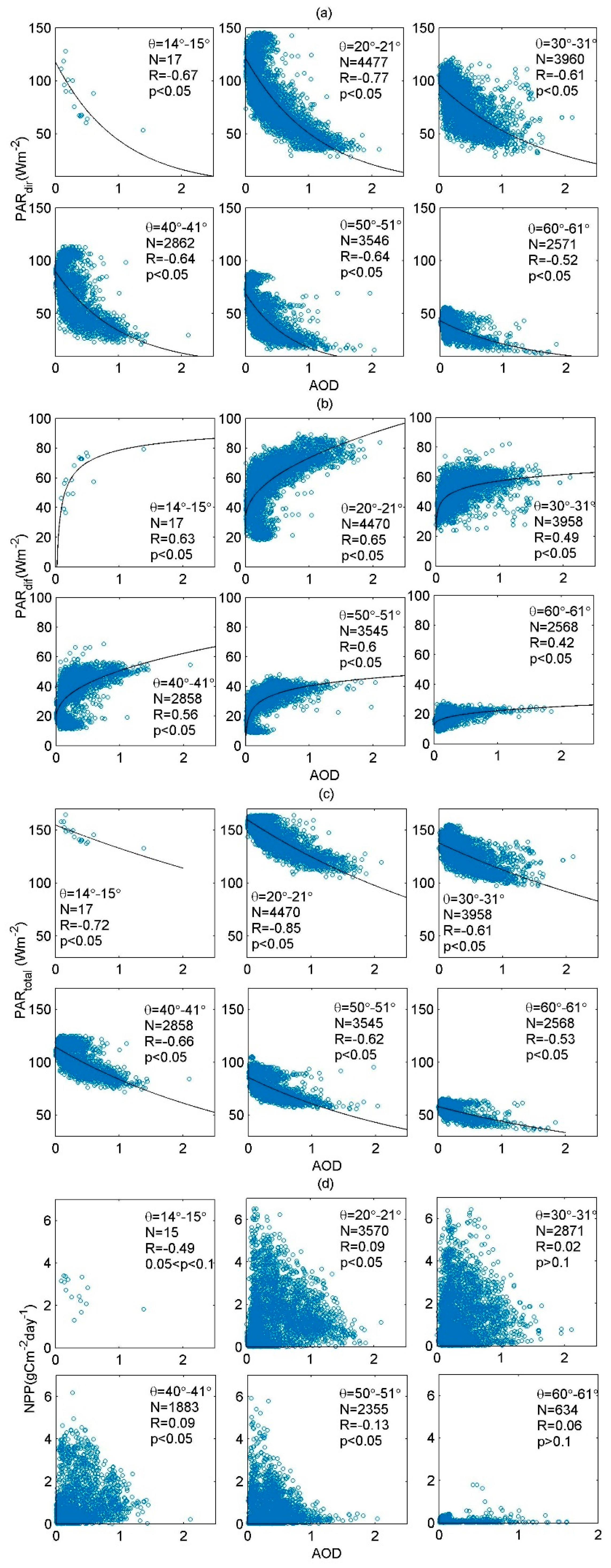
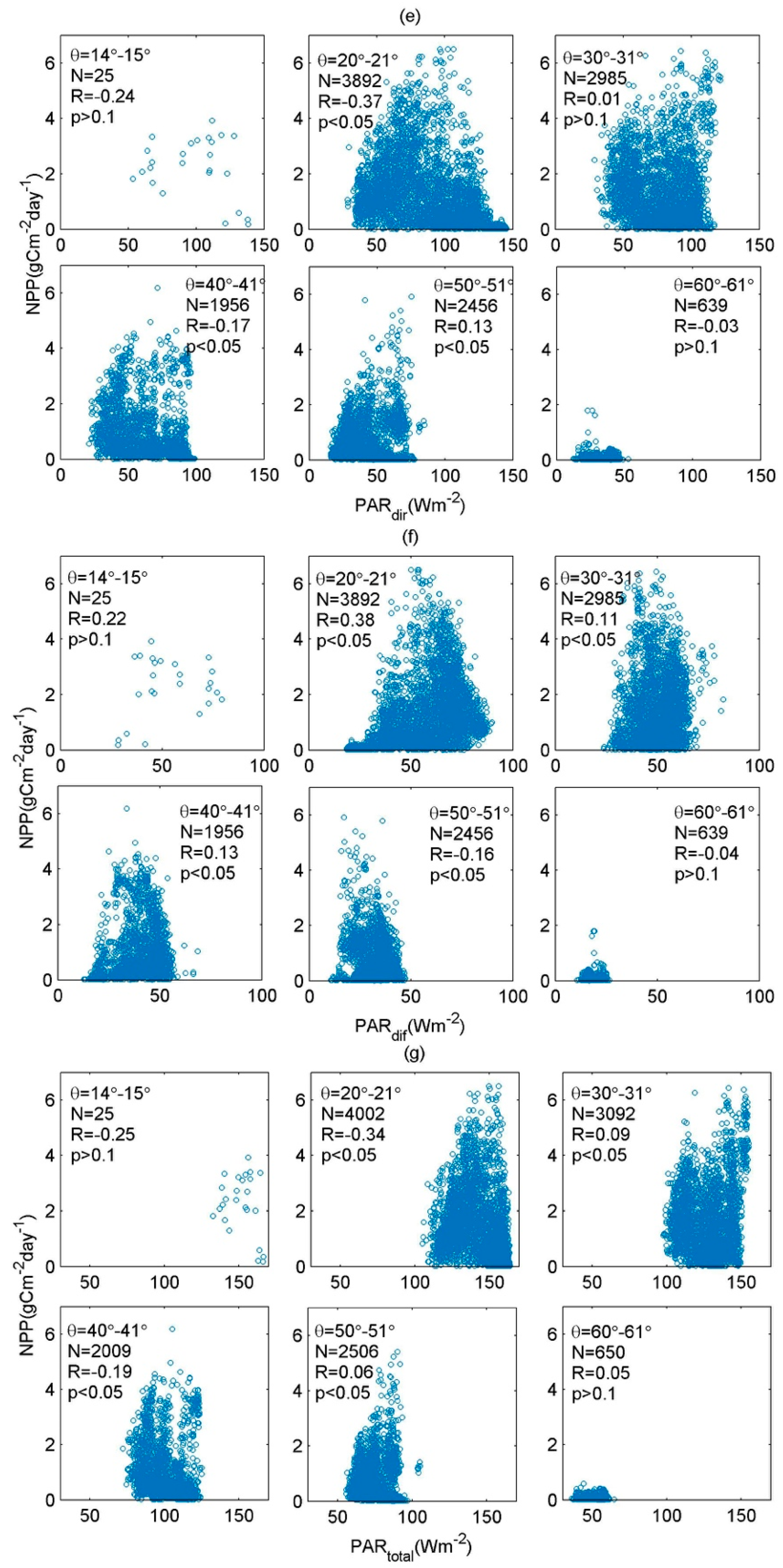
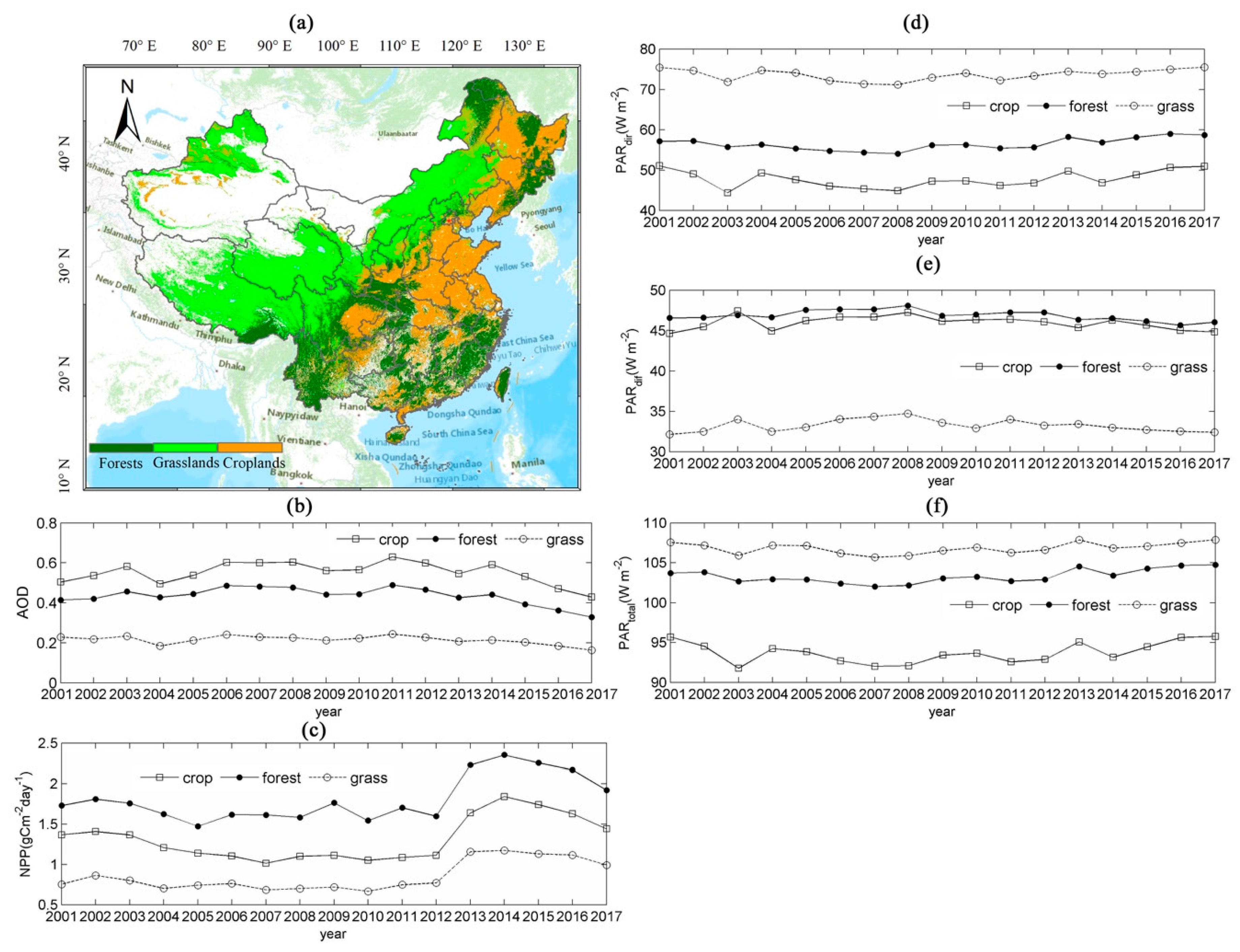
| Vegetation Cover | AOD | PARdir (Wm−2) | PARdif (Wm−2) | PARtotal (Wm−2) | NPP (gCm−2day−1) | ||||||||||
|---|---|---|---|---|---|---|---|---|---|---|---|---|---|---|---|
| Mean | Trend | Mean | Trend | Mean | Trend | Mean | Trend | Mean | Trend | ||||||
| 2001–2008 | 2009–2017 | 2001–2008 | 2009–2017 | 2001–2008 | 2009–2017 | 2001–2008 | 2009–2017 | 2001–2008 | 2009–2017 | ||||||
| China | 0.337 | 0.004 ** | −0.007 ** | 64.145 | −0.515 ** | 0.238 ** | 39.084 | 0.249 ** | −0.096 ** | 103.234 | −0.248 ** | 0.143 ** | 1.265 | −0.016 | 0.035 ** |
| Croplands | 0.552 | 0.013 ** | −0.016 ** | 47.778 | −0.723 ** | 0.384 ** | 45.964 | 0.267 ** | −0.112 ** | 93.741 | −0.467 ** | 0.326 ** | 1.316 | −0.015 | 0.062 ** |
| Forests | 0.435 | 0.011 ** | −0.015 ** | 56.432 | −0.508 ** | 0.368 ** | 46.867 | 0.246 ** | −0.139 ** | 103.299 | −0.252 ** | 0.254 ** | 1.808 | −0.003 | 0.074 ** |
| Grasslands | 0.213 | 0.002 | −0.007 ** | 73.598 | −0.495 ** | 0.223 ** | 33.233 | 0.267 ** | −0.117 ** | 106.831 | −0.193 ** | 0.119 ** | 0.846 | −0.002 | 0.015 ** |
| Region | AOD | PARdir (Wm−2) | PARdif (Wm−2) | PARtotal (Wm−2) | NPP (gCm−2day−1) | ||||||||||
|---|---|---|---|---|---|---|---|---|---|---|---|---|---|---|---|
| Mean | Trend | Mean | Trend | Mean | Trend | Mean | Trend | Mean | Trend | ||||||
| 2001–2008 | 2009–2017 | 2001–2008 | 2009–2017 | 2001–2008 | 2009–2017 | 2001–2008 | 2009–2017 | 2001–2008 | 2009–2017 | ||||||
| NP | 0.684 | 0.025 ** | −0.020 ** | 44.757 | −1.124 ** | 0.569 ** | 44.134 | 0.301 ** | −0.151 ** | 88.891 | −0.760 ** | 0.358 ** | 0.972 | −0.015 | 0.054 ** |
| YRD | 0.608 | 0.015 ** | −0.019 ** | 44.665 | −0.598 ** | 0.430 ** | 54.010 | 0.200 ** | −0.059 ** | 98.593 | −0.326 ** | 0.378 ** | 1.701 | −0.021 | 0.073 ** |
| CC | 0.649 | 0.020 ** | −0.028 ** | 40.438 | −0.560 ** | 0.745 ** | 57.070 | 0.114 | −0.169 ** | 98.176 | −0.382 ** | 0.572 ** | 1.520 | −0.023 ** | 0.062 ** |
| SCB | 0.673 | 0.015 ** | −0.038 ** | 46.637 | −0.741 ** | 0.793 ** | 54.112 | 0.422 ** | −0.240 ** | 100.749 | −0.361 ** | 0.541 ** | 1.322 | 0.006 | 0.073 ** |
| GD | 0.599 | 0.011 | −0.020 ** | 57.595 | −0.324 | 0.170 | 53.782 | 0.102 | −0.027 | 111.378 | −0.229 | 0.139 ** | 1.833 | −0.009 | 0.114 ** |
| Vegetation Cover | RAOD_PARdir | RAOD_PARdif | RAOD_PARtotal | RAOD_NPP | RPARdir_NPP | RPARdif_NPP | RPARtotal_NPP |
|---|---|---|---|---|---|---|---|
| China | −0.482 ** | 0.408 ** | −0.516 ** | −0.066 ** | 0.131 ** | −0.130 ** | 0.114 ** |
| Croplands | −0.503 ** | 0.388 ** | −0.536 ** | −0.138 ** | 0.164 ** | −0.140 ** | 0.162** |
| Forests | −0.478 ** | 0.381 ** | −0.531 ** | −0.119 ** | 0.215 ** | −0.218 ** | 0.187 ** |
| Grasslands | −0.326 ** | 0.268 ** | −0.357 ** | −0.084 | 0.182 ** | −0.159 ** | 0.186 ** |
| Region | RAOD_PARdir | RAOD_PARdif | RAOD_PARtotal | RAOD_NPP | RPARdir_NPP | RPARdif_NPP | RPARtotal_NPP |
|---|---|---|---|---|---|---|---|
| NP | −0.516 ** | 0.429 ** | −0.520 ** | −0.177 ** | 0.171 ** | −0.133 | 0.236 ** |
| YRD | −0.506 ** | 0.389 ** | −0.542 ** | −0.076 | 0.186 ** | −0.205 ** | 0.181 ** |
| CC | −0.569 ** | 0.417 ** | −0.609 | −0.226 ** | 0.244 ** | −0.219 ** | 0.220 ** |
| SCB | −0.342 ** | 0.237 ** | −0.414 | −0.234 ** | 0.338 ** | −0.313 ** | 0.310 ** |
| GD | −0.489 ** | 0.379 ** | −0.557 ** | −0.223 ** | 0.300 ** | −0.313 ** | 0.219 ** |
© 2020 by the authors. Licensee MDPI, Basel, Switzerland. This article is an open access article distributed under the terms and conditions of the Creative Commons Attribution (CC BY) license (http://creativecommons.org/licenses/by/4.0/).
Share and Cite
Li, X.; Liang, H.; Cheng, W. Spatio-Temporal Variation in AOD and Correlation Analysis with PAR and NPP in China from 2001 to 2017. Remote Sens. 2020, 12, 976. https://doi.org/10.3390/rs12060976
Li X, Liang H, Cheng W. Spatio-Temporal Variation in AOD and Correlation Analysis with PAR and NPP in China from 2001 to 2017. Remote Sensing. 2020; 12(6):976. https://doi.org/10.3390/rs12060976
Chicago/Turabian StyleLi, Xin, Hongyu Liang, and Weiming Cheng. 2020. "Spatio-Temporal Variation in AOD and Correlation Analysis with PAR and NPP in China from 2001 to 2017" Remote Sensing 12, no. 6: 976. https://doi.org/10.3390/rs12060976
APA StyleLi, X., Liang, H., & Cheng, W. (2020). Spatio-Temporal Variation in AOD and Correlation Analysis with PAR and NPP in China from 2001 to 2017. Remote Sensing, 12(6), 976. https://doi.org/10.3390/rs12060976






